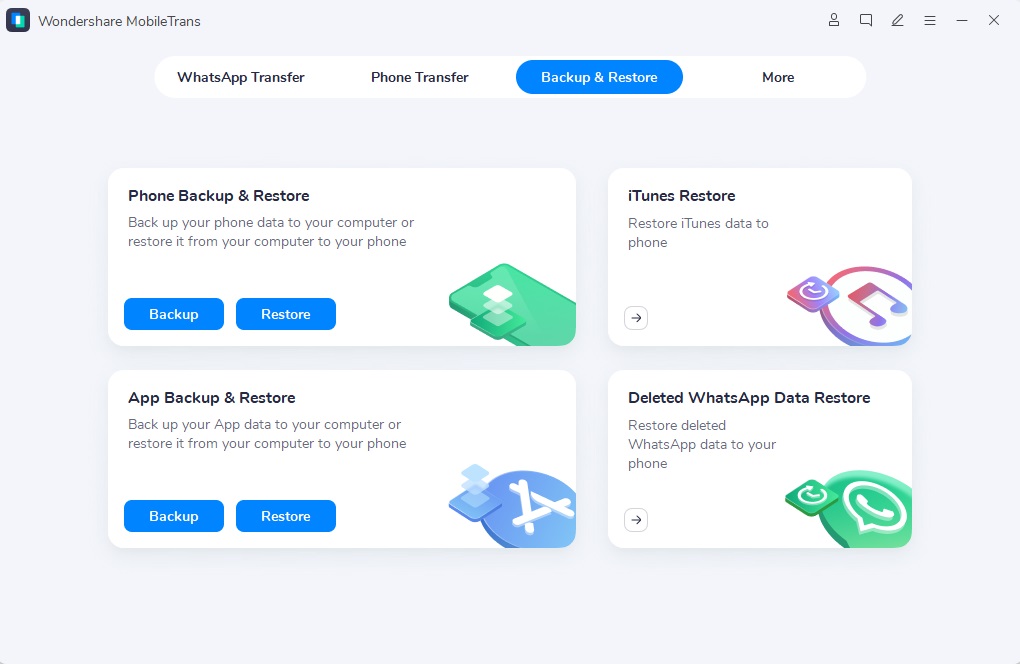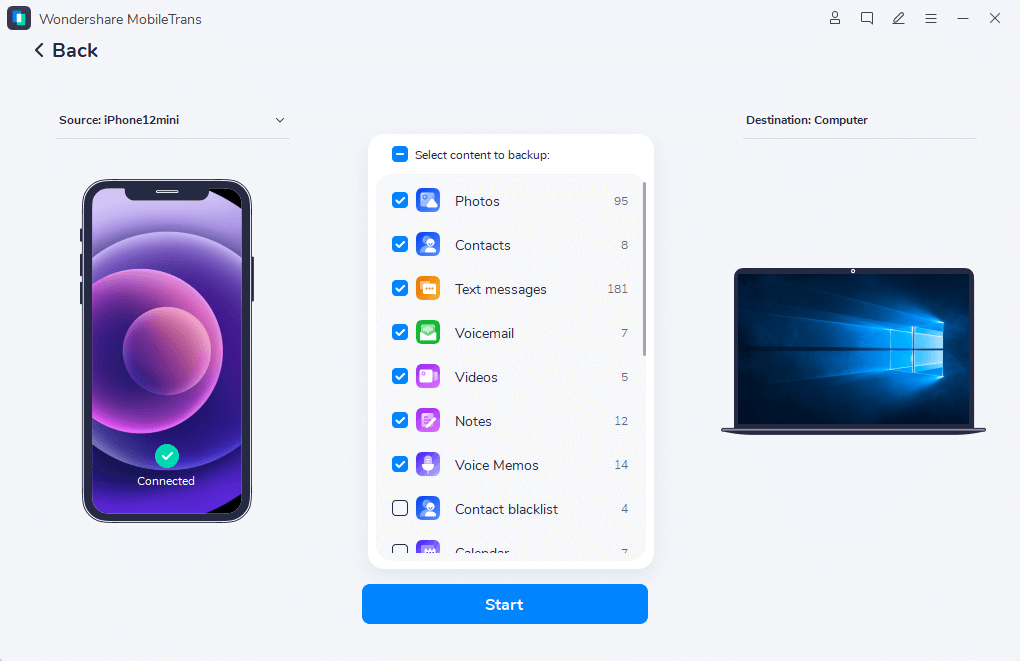Samsung Cloud is a cloud storage service that comes pre-installed on Samsung devices, allowing users to back up and sync data across multiple devices. It provides 15GB of free storage space for backing up photos, videos, contacts, messages, and more.
If you have backed up photos to Samsung Cloud before, you may wonder how you can view or retrieve those photos later, especially when you have changed or lost your Samsung device.
This article will guide you through the steps to access Samsung Cloud and how to retrieve photos from Samsung Cloud using numerous methods.
In this article
How to Access Samsung Cloud?
To view or retrieve your photos from Samsung Cloud, you must first access your Samsung account and Samsung Cloud storage. You can use these methods to access Samsung Cloud:
- On a Samsung device - Open the Settings app on your Samsung phone or tablet, go to Accounts and Backup > Samsung Cloud. Sign in with your Samsung account credentials. This will give you access to the photos and data stored in your Samsung Cloud.

- On the Samsung Cloud website - Go to cloud.samsung.com on any internet browser. Sign in with your Samsung account details. Here you can view and manage all data backed up from your Samsung devices. On Samsung Cloud’s web version, you can access various features like Gallery, Samsung Notes, Cloud Drive, Find My Mobile, and Settings.

- Using the Samsung Cloud app - There is a dedicated Samsung Cloud app available for download on the Google Play Store and Galaxy Store. Install it on your Android device, sign in to your Samsung account and you will be able to access your cloud storage.

The easiest way is via a Samsung device you are currently using where Samsung Cloud should already be logged in. But if you no longer have your old Samsung phone, using the website or app is a good alternative.
Make sure to use the Samsung account details that were last connected to the device holding the photos you want to retrieve.
How to Retrieve Photos from Samsung Cloud
Samsung Cloud has been a leading cloud storage solution for Samsung device users over the years. However, with the recent announcement that Samsung Cloud will be shutting down soon.
In 2021, Samsung announced it will shut down major parts of Samsung Cloud including Gallery Sync, Cloud Drive, and Premium Storage. Samsung advised users to move their data to OneDrive before specified deadlines, otherwise they risk losing access to content stored on Samsung Cloud. So, it simply means that Samsung Cloud will be available but it will no longer back up your files.
Many users are now wondering how they can continue accessing their Samsung Cloud accounts and data. Don’t worry though. You’ve come to the right place.
Here, we offer you different solutions based on your specific situation. For those who synced your Samsung Cloud account with OneDrive, you can retrieve photos from there. If you didn’t do that, you can also choose to restore photos from Samsung Cloud storage or the Gallery app.
To restore pictures from the Samsung Cloud (synced with OneDrive), you can use any of the below-listed methods.
Method 1: Retrieve Photos from Samsung Cloud Using OneDrive
Once you have accessed your Samsung Cloud storage through one of the above methods, you can easily view and download the photos stored in it.
To back up your photos to OneDrive, follow these steps:
Step 1: Launch the Gallery app on your phone and access the Menu tab.
Step 2: Navigate to Settings, select Sync with OneDrive, and save the files to your account. You may need to log in to your Microsoft account during this process.

Step 3: Open your preferred web browser and visit the official OneDrive website. Alternatively, you can also use the OneDrive mobile app to download and restore photos from Samsung Cloud.
Step 4: Identify the photos you wish to restore, then choose them. Click on the Download option to initiate the recovery process.

If you cannot find the download icon, you may check the three-dot menu at the top and select the Download option to save your files.
Method 2: Retrieve Photos from Samsung Cloud Directly
To restore your data from Samsung Cloud directly, follow these steps:
Step 1: Begin by opening the Settings menu, and scroll down to the bottom. Tap on Accounts & Backup. Select the Restore data option now to proceed.

Step 2: Following that, pick the file types you want to retrieve—specifically, Photos or Gallery, depending on your phone model. Finally, click on the Restore tab to initiate the file recovery process.
Method 3: Retrieve Photos from Samsung Cloud Using the Gallery App
You can also download photos from Samsung Cloud within the Gallery app on your phone:
Step 1. Navigate to the Gallery app, go to Settings, and tap on Sync with Samsung Cloud.

Step 2: Within the Gallery cloud data page, select "Recently added," and tap the arrow icon to choose and download the photos you desire.
And that’s it! In summary, Samsung Cloud provides multiple intuitive interfaces to view and download your backed-up photos - on Samsung devices via the app, on any device via the website, or on Android devices via the Samsung Cloud app.
Just access your Samsung Cloud storage using any of these methods, open the Gallery to view your albums, select the photos you want, and download them to your current device or computer for seamless retrieval from the cloud!
What Can Be Backed Up to Samsung Cloud?
Samsung Cloud allows you to back up much more than just photos. Here are the different types of data you can backup:
- Photos and videos - All the images and videos captured on your Samsung device can be backed up at their original quality.
- Contacts - Back up your phone contacts including names, numbers, and other details.
- Calendar events - Back up all scheduled events and reminders.
- Samsung Notes - Backs up all your Samsung Notes documents.
- App data - Data within supported apps can be synced across devices.
- Settings - Backup device settings like home screen layout, wallpapers, alarms, etc.
- SMS messages - Back up your text messages to the cloud.
- Call logs - Logs of incoming and outgoing calls are backed up.
- Documents - Files and documents like PDFs can also be backed up.
- Keyboard data - Custom keyboard settings, input languages, predictive text data, etc.
To set up a backup for any of the above, go to Settings > Accounts and Backup > Samsung Cloud > Backup settings on your Samsung device. Here, tick the data types you want to back up.
The selected content will automatically sync to the cloud whenever the device is charging, connected to WiFi, and the screen is off.
Retrieve Backed Up Photos Without Samsung Cloud
If you no longer have access to your Samsung account but need to restore Samsung Cloud photos from an old device, third-party software like Wondershare MobileTrans can help.
Wondershare MobileTrans - Backup & Restore is a data transfer tool that allows restoring backups from one phone to another, even without cloud storage.
It supports both Android and iOS devices. With MobileTrans, you can back up and restore over 18 types of data, including photos, videos, contacts, messages, etc.
The key advantages of using MobileTrans:
- Does not require Samsung Cloud access or login credentials.
- Allows restoring from offline backups as well.
- Transfers photos directly to the new phone, bypassing the cloud.
- More customizable with options to select data types to transfer.

 4.5/5 Excellent
4.5/5 ExcellentHere are the steps to use MobileTrans to retrieve your photos:
Step 1: Download and install MobileTrans on your computer. Open MobileTrans on your device.
Step 2: Connect your mobile device to the computer using a USB cable. Ensure that your device is recognized by MobileTrans.
Step 3: In the MobileTrans interface, switch to the Backup and Restore tab. Tap on the Backup button placed in the Phone Backup and Restore tab.

Step 4: MobileTrans should detect the available backups. Choose the backup that contains the photos you want to retrieve. Choose the specific types of data you want to restore. In this case, select "Photos".

Step 5: Click Start and MobileTrans will extract photos from the old device backup and transfer them to your new phone.
Step 6: Disconnect your device from the computer and check your photo gallery to ensure that the photos have been successfully retrieved.
In a word, if you ever lose access to your Samsung Cloud storage and account, MobileTrans provides an alternate route to restore your backed-up phone content and precious photos through the backup file itself.
Conclusion
This wraps up our guide on how to retrieve photos from samsung cloud. Samsung Cloud provides a convenient way to backup photos, videos, contacts, and other data from Samsung devices automatically.
Whenever you need to retrieve the data, you can simply access Samsung Cloud via the website, app, or a Samsung device. From here, you can view media files like photos stored on the cloud and download them back to your phone or computer.
With the steps provided in this article, you can seamlessly restore your Samsung Cloud photos. Even without access to Samsung Cloud, solutions like MobileTrans make it possible to transfer backup files from one device to another directly.

 4.5/5 Excellent
4.5/5 ExcellentFAQ
-
What happened to Samsung Cloud photos?
Samsung Cloud used to provide a seamless photo syncing and backup solution for Samsung device users. However, in 2021, Samsung announced it will be discontinuing the photo sync features of Samsung Cloud, including Gallery Sync. So in summary - new photos can no longer be auto-backed up but existing photos are still retrievable from Samsung Cloud if you act quickly. Download them to your device for long-term safekeeping. -
How do I backup my Samsung Cloud photos before the shutdown?
You have a few options to back up your Samsung Cloud photos before the service shuts down: Download the photos to your Samsung device storage or computer. Sync and backup the photos to OneDrive. Download and transfer the photos to external storage like a USB drive or hard disk. Manually download and backup your Samsung Cloud albums and photos regularly before the shutdown. This will create offline copies you can access later. The key is to not rely solely on Samsung Cloud. Maintain your own backups by downloading photos to your devices or external storage frequently.






